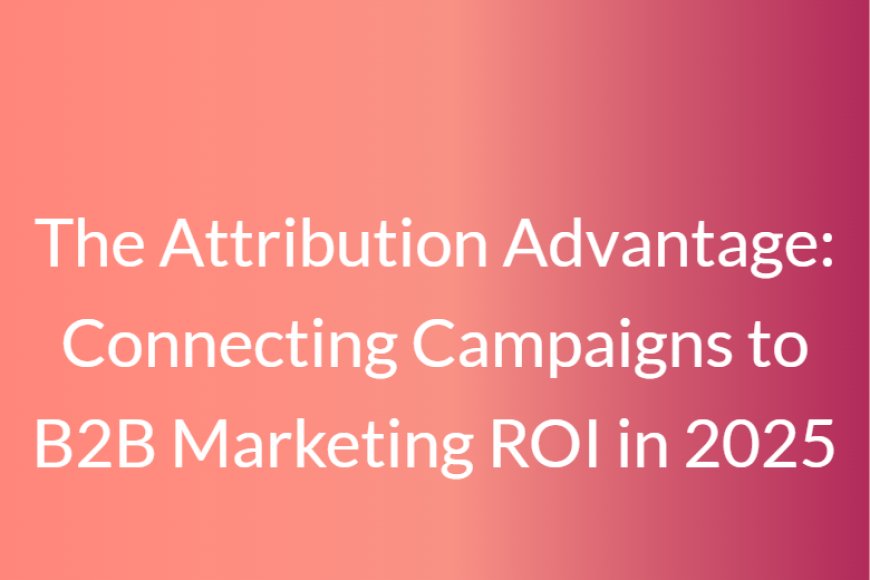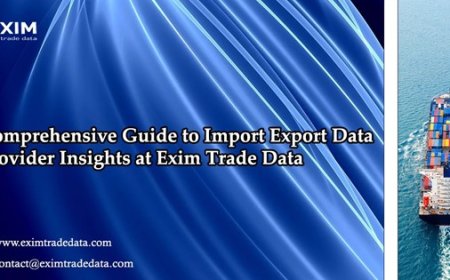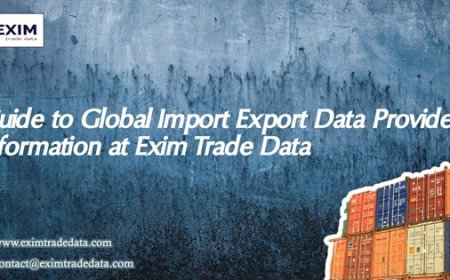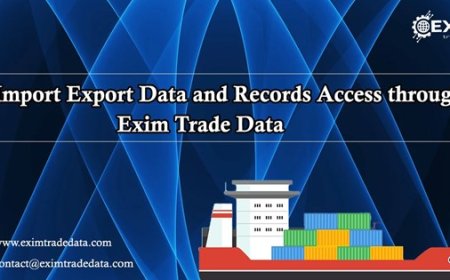The Attribution Advantage: Connecting Campaigns to B2B Marketing ROI in 2025
As B2B marketing matures in 2025, the focus is no longer on merely generating traffic or leads it’s on delivering measurable business outcomes.

One of the most critical tools for marketers striving to prove value is attribution. The ability to accurately connect touchpoints to outcomes is giving modern marketers a distinct edge in optimizingB2B Marketing ROI
.
Attribution is how marketers know whats working, whats underperforming, and where to invest. With longer sales cycles, multiple decision-makers, and countless channels, understanding how each marketing effort contributes to revenue is no longer optional its a necessity for sustained growth.
Why Attribution is a Priority in 2025
In todays B2B environment, marketing teams are accountable not just for generating awareness but for directly impacting the pipeline. Executives demand transparency on how marketing dollars translate into revenue. This demand is pushing marketers to refine attribution models and shift focus toward performance-driven strategies that elevate B2B Marketing ROI.
Attribution enables data-informed decisions. It helps eliminate guesswork, prioritize high-performing campaigns, and justify budget reallocations. Instead of treating all channels equally, marketers now double down on what truly drives conversions and sales.
Multi-Touch Attribution in a Multi-Channel World
B2B buying journeys are no longer linear. A prospect may discover a company through a LinkedIn ad, read several blogs, download a whitepaper, attend a webinar, and only then engage with sales. In this complex web of touchpoints, last-touch attribution fails to capture reality.
Multi-touch attribution (MTA) provides a more comprehensive view. It assigns value to every interaction that influenced a deal from the first impression to the final call. Marketers in 2025 rely on MTA models to understand full-funnel behavior and improveB2B Marketing ROI by identifying key campaign contributors.
Sophisticated attribution tools track touchpoints across platforms and devices, allowing marketers to see which combinations produce the best results and scale those tactics accordingly.
Choosing the Right Attribution Model for Accuracy
There is no one-size-fits-all when it comes to attribution models. Choosing the right model depends on your sales cycle, business goals, and marketing structure. In 2025, top-performing B2B teams often use a blend of models to evaluate ROI holistically.
First-touch attribution is helpful for analyzing brand discovery channels. Last-touch shines in conversion-focused campaigns. Linear models offer a balanced view by assigning equal credit across touchpoints, while time-decay models emphasize recency.
Custom data-driven models powered by AI are becoming more common. These models automatically assign weight to each touchpoint based on actual conversion influence, leading to more accurate ROI insights and sharper B2B Marketing ROI strategies.
Campaign Optimization Fueled by Attribution Insights
Attribution doesnt just measure impact it guides strategy. In 2025, attribution data is being used to optimize everything from budget distribution to content development.
If attribution reveals that webinars generate more pipeline than paid search, resources can be reallocated accordingly. If certain blog posts consistently drive mid-funnel conversions, those topics can be expanded or repurposed for nurture campaigns.
Marketers who use attribution insights to make agile adjustments see higher engagement rates, stronger lead quality, and faster deal velocity. These improvements lead directly to increased B2B Marketing ROI across all programs.
Aligning Attribution with Sales Outcomes
Attribution works best when marketing and sales are aligned. In 2025, successful B2B organizations treat attribution as a shared tool for understanding the complete revenue journeynot just a marketing metric.
Marketing teams share attribution dashboards with sales to show which campaigns influenced closed-won deals. Sales teams provide feedback on lead quality, buying behavior, and opportunity progression.
This feedback loop allows for real-time calibration. Together, both teams can identify which segments, assets, and messaging strategies are contributing to revenue, creating a more unified approach to improving B2B Marketing ROI.
Integrating Attribution Across the Martech Stack
For attribution to deliver meaningful insights, it must be integrated across all platformsCRM, marketing automation, email, ads, and content systems. In 2025, seamless integration ensures accurate data collection and a holistic view of buyer activity.
A fully connected stack allows attribution tools to track every digital and offline interaction. Whether it's a PPC ad click, email open, video view, or sales call, each touchpoint feeds into the attribution model.
Marketers get real-time insights on campaign effectiveness, while decision-makers gain visibility into how investments impact growth. This complete view enables smarter budgeting and better optimization of B2B Marketing ROI across every channel.
Content Attribution and the Role of Educational Assets
Content remains central to B2B marketing, but proving its ROI has often been difficult. In 2025, content attribution tools are helping marketers understand how blogs, whitepapers, videos, and webinars contribute to the pipeline.
By tagging and tracking every content asset, marketers can see which pieces are engaged by high-value leads. They can identify which assets influence conversions and which are ignored, allowing them to invest in content that performs.
When content is connected to actual revenue outcomes, it becomes a strategic asset. Content teams are empowered to build targeted materials that influence decisions, thereby strengthening overall B2B Marketing ROI.
Budget Planning Backed by Attribution Data
Attribution insights empower marketers to approach budget planning more strategically. Rather than relying on historical spend or intuition, 2025 marketers use attribution data to guide investment decisions.
Channels that deliver high ROI receive larger budgets. Underperforming channels are paused, tested, or eliminated. Forecasting becomes more accurate because its grounded in real performance, not assumptions.
Marketing leaders use this data to justify spend in board meetings and allocate resources based on real impact, ensuring that every dollar spent contributes to improving B2B Marketing ROI in measurable ways.
Predictive Attribution for Smarter Campaign Planning
Looking beyond retroactive analysis, predictive attribution models are helping marketers plan future campaigns with greater confidence. By analyzing patterns in past performance, these AI-powered tools forecast how new campaigns are likely to perform.
Marketers can simulate different campaign combinations, targeting parameters, or messaging styles to predict which mix will generate the best outcomes. These predictive models guide creative decisions and improve campaign structure before launch.
This proactive approach to campaign planning reduces risk and increases the likelihood of hitting pipeline targets ultimately contributing to strongerB2B Marketing ROI and more predictable revenue growth.
Measuring ROI in Complex Buying Cycles
B2B buying decisions are complex, often involving multiple departments and extended timeframes. Attribution models in 2025 are designed to account for these complexities by recognizing the collective influence of multiple interactions.
Sophisticated attribution tracks how touchpoints resonate with each persona within a buying committee. It reveals which content, channels, and timing influence IT leaders versus finance or procurement.
This level of granularity allows marketers to design campaigns that cater to each influencer while maintaining message consistency. The result is stronger engagement across the board and improved B2B Marketing ROI from strategic personalization.
Driving Cultural Change with Attribution Transparency
Finally, attribution is transforming how B2B marketing teams are viewed within the organization. By making performance transparent and data-driven, marketing gains credibility as a revenue generator not just a cost center.
Attribution builds a culture of accountability and learning. Teams celebrate what works, share insights cross-functionally, and iterate based on real data. Executives gain confidence in marketings impact, leading to better alignment and more support.
With attribution guiding every decision, marketing becomes a strategic partner in business growth. This internal shift is one of the biggest drivers of long-term B2B Marketing ROI and sustained performance across departments.
Read the Full Blog Now https://acceligize.com/featured-blogs/how-to-maximize-b2b-marketing-roi-in-2025/
About Us
Acceligize is a global B2B lead generation and demand generation company helping enterprises and agencies scale their revenue pipeline through targeted marketing solutions. With expertise in account-based marketing, multichannel outreach, and intent-based targeting, Acceligize builds impactful B2B marketing campaigns that deliver results. Our data-driven approach ensures that your brand connects with the right audience, at the right time, through the right channels maximizing ROI and accelerating growth.































